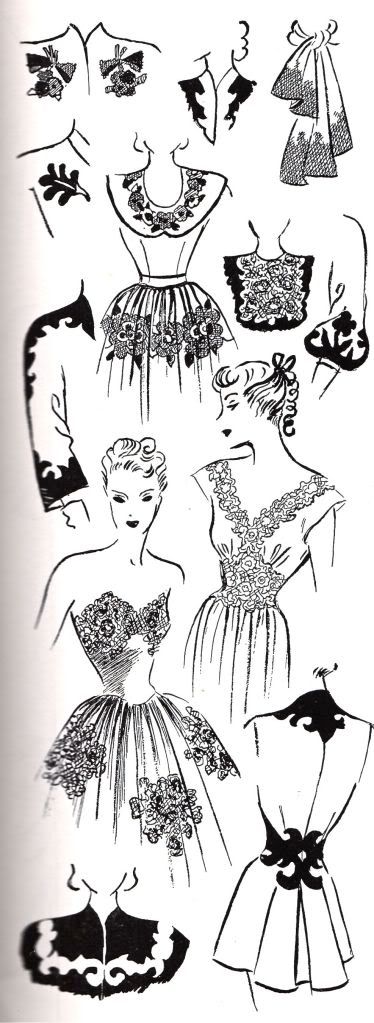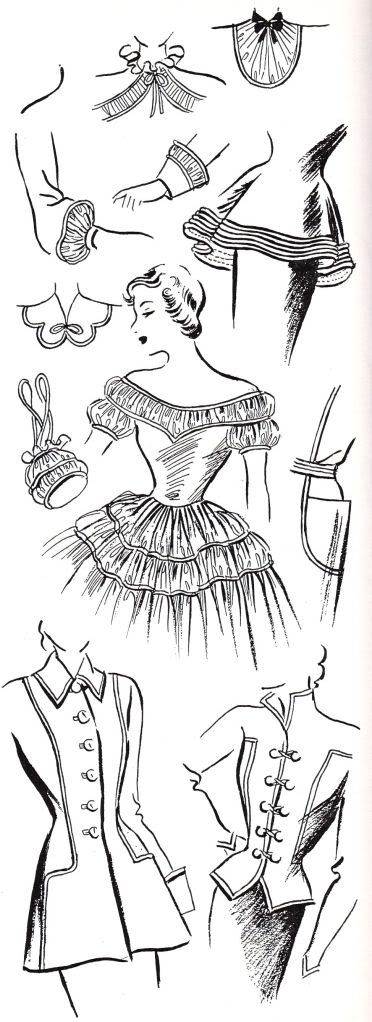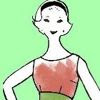Designers' Sketches the fashion sketches here and on the following page show how designers use the decorative finishes. Fashion is selective. One season banding or braiding is favored, the next may bring shirrings, gatherings, puffings, or flounces. These illustrations are given to stir your imagination and show the variety of possibilities in such decorations. Experienced buyers realize that the difference in price ranges of ready-made garments depends less on the cost of fabric than on the good workmanship of the better clothing. The more expensive the dress, the more certain you are to find details such as these in its construction.

Bands and Edges Edge-Stitcher. Wherever straight smooth edges and narrow inconspicuous joinings are required, the Edge-Stitcher proves its worth. Net, lace and filmy fabrics which are to be stitched together in bands or in all-over effects, such as the blouse at, top-center, are beautifully handled by the Edge-Stitcher. This attachment is also valuable for giving a crisp edge to perky ruffles, as around the neckline at bottom, and when bands of fabric, ribbon or braid are used, as in the skirt and the sleeve shown. For very fine work, use matching thread, a short stitch, and tissue paper underneath for protection.

The Zigzagger for Applique. Of all the practical Fashion Aids which the sewing machine provides, none contributes more to the beauty of both design and fabric than does the Zigzagger. With it, you can applique the most intricate, time-taking designs, doing the work even more effectively and with far less handling than by hand. This page shows you only a few of the ways in which it can serve you. The zigzag stitching line it makes back and forth across the joining is ideal for applying the shaped edges of lace to filmy fabric, as in lingerie and evening wear. For applying fabric motifs, it also makes an excellent secure and inconspicuous edge finish. Flower motifs, conventional designs, monograms may all be applied in this easy way. The particular advantage of applique is that it lends interest through contrast-contrast of textures, of color, and of design. The tracery of the outline against a plain surface is eye-catching. Velvet on broadcloth, taffeta on satin, satin or taffeta on organdie, taffeta on satin or net, net or lace on chiffon, plain cotton on printed, or plain silk on printed-these are only a few of the possible combination's you can use. On sheer fabrics, self applique gives the shadowy contrast of a double thickness. If you are not expert with the Zigzagger, go to a Singer Shop and learn how to use it for applique.

Feminine Frills Ruffles. Feminine as a powder puff, ruffles are the essence of daintiness. The infinite, variety of ways to use ruffles is just hinted in the illustrations opposite. With your machine Ruffler and Gathering Foot you can make these perfectly and with a minimum of effort. Center-stitched ruffles, applied on a curved line, are used in the round-necked blouse at the top and the evening dress at the bottom, tiered ruffles in the petticoat showing beneath the lifted skirt. The blouse front at top left has a ruffle inserted in a seam. The all-over ruffled effect in the jacket just below is obtained by applying center-stitched ruffles along parallel lines marked in the fabric. Ruffles generally are best cut on a true bias, hemmed, picoted, or lace-trimmed, then plaited or gathered. They may, however, be made of ribbon, of lace, of a bias fold. Always press your ruffle after the edge is finished and before gathering the top. Keep ruffling in a box-do not let it get wrinkled after it has been gathered.

Corded Finishes Cording. The illustrations here give you an idea of the many ways in which your machine Cording Foot can help you in achieving attractive and professional-looking details. Cording may be made of self-material or in contrasting color, depending on whether a color accent is desired or not. When inserted in seam lines, cording gives weight and importance to the lines of the garment. It also makes an attractive edge finish for collars, necklines, cuffs and jackets, as shown. Several additional rows of cording may be put in above the edge to give the effect shown in the flared tunic illustrated. Where a shirred section joins plain fabric, as in the blouse front at the top, cording may be inserted to give the joining a nice finish. The center dress and the bag show how corded shirring holds and distributes fullness, and the shirred bands at the top illustrate the use of cording to give a firm neat finish at the edges of the bands.

Trimming with Braid Braiding. The sketches opposite show a few designs for braid trimming. Make your own motifs, choose a transfer pattern, or take a rubbing from a pattern and transfer this to your fabric for the braiding lines. Learn to use both the Braiding Foot and the Underbraider expertly before beginning such work. Then braiding can give you a decorative touch at neckline or pocket. It can accent the lines of a long-torso dress or a short bolero. Braid can add distinction to a simply cut evening wrap and give a note of interest to a plain bodice or the lapels or peplum of a dressmaker suit.


Fantastic post today! And the pictures are really inspiring. Makes me want to go out and sew something fantastic.
ReplyDeleteI have this book, too; isn't it a treasure? The illustrations are a constant source of inspiration.
ReplyDeleteAnd these beautiful things were done without computer machines, no sergers, no embroidery machines...just skill and talent. Wow.
ReplyDeletehi
ReplyDeletenice blog
im a stylish
so i need these kind of informations
Thanks alot
rina soe
www.rinaface.blogspot.com
Thanks, they are so pretty!
ReplyDelete